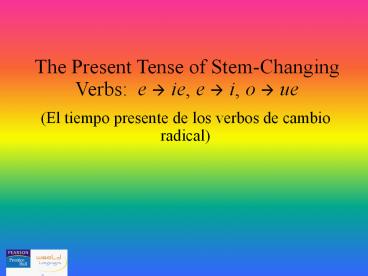Stem-changing verbs PowerPoint PPT Presentation
Title: Stem-changing verbs
1
The Present Tense of Stem-Changing Verbs e ?
ie, e ? i, o ? ue
(El tiempo presente de los verbos de cambio
radical)
2
There is a fairly large group of verbs in Spanish
that undergo changes in their stem when
conjugated in the present tense. These changes
occur only in the first and second persons
singular and third persons singular and plural.
When a line is drawn around the forms that
change, the resulting shape vaguely resembles a
boot or high-top shoe thus, these verbs are
sometimes informally called boot or shoe
verbs.
There are three types or classes of boot verbs.
3
Type 1 e ? ie
Well use entender, to understand, as an example
of this type.
- entender
entiendo entiendes entiende
entendemos entendéis entienden
The stem undergoes the change only when stressed.
4
Here are some other common e ? ie verbs
empezar, comenzar
to begin
pensar ( infinitive)
to think to plan (to do something)
perder
to lose
preferir
to prefer
querer
to want, to love
5
tener, venir
The verbs tener and venir are what might be
called partial stem-changing verbs the yo forms
do not have the stem change, but they do have an
irregularity.
tengo tienes tiene
tenemos tenéis tienen
Tengo exámenes mañana.
I have exams tomorrow.
vengo vienes viene
venimos venís vienen
Vengo de la biblioteca.
Im coming from the library.
6
Type 2 e ? i
Well use servir, to serve, as an example of this
type.
- servir
sirvo sirves sirve
servimos servís sirven
Note All e ? i verbs are -ir verbs.
7
Here are some other common e ? i verbs
medir
to measure, to be a certain height
pedir
to ask for, to request
repetir
to repeat, to have a second helping
teñir
to dye, to color
8
Type 3 o ? ue
Well use almorzar, to have lunch, as an example
of this type.
- almorzar
almuerzo almuerzas almuerza
almorzamos almorzáis almuerzan
9
The verb jugar, to play (games or sports),
follows the same pattern as o ? ue verbs, but the
change is u ? ue.
- jugar
juego juegas juega
jugamos jugáis juegan
10
Here are some other common o ? ue verbs
costar
to cost
dormir
to sleep
encontrar
to find
poder
to be able can
recordar
to remember
soñar (con)
to dream (about)
volver
to return, to come back
Costar is normally used only in the third
persons.
11
The verbs querer and preferir
Expressing desires and preferences
Querer and preferir are important stem-changing
verbs that have multiple uses.
12
querer
quiero quieres quiere
queremos queréis quieren
When used with a thing as the direct object,
querer means to want.
13
Quiere un sándwich de pollo?
Sí, y quiero papas fritas también, por favor.
14
querer
quiero quieres quiere
queremos queréis quieren
When used with a person as the direct object,
querer means to love.
15
Quiero mucho a su hija, señor Vega.
16
preferir
prefiero prefieres prefiere
preferimos preferís prefieren
Preferir, of course, means to prefer.
17
Quiere un sándwich de pollo?
No señor, prefiero una hamburguesa.
18
Both querer and preferir can be used with an
infinitive directly after them
We start with an appropriate person and number of
querer or preferir . . .
and then add any infinitive.
estudiar
leer
estudiar
quiero
queremos
escribir
comer
quieres
queréis
viajar
aprender
quiere
quieren
bailar
dormir
Rafael quiere esquiar, pero su novia prefiere
patinar.
Rafael wants to ski, but his girlfriend prefers
to skate.
19
Thinking and planning
The verb pensar is another very useful
stem-changing verb.
pienso piensas piensa
pensamos pensáis piensan
20
Thinking and planning
Pensar basically means to think.
Me gusta ir al parque para pensar y descansar.
I like to go to the park to think and rest.
21
Thinking and planning
Pensar en means to think about.
Gabriela siempre piensa en sus estudios.
Gabriela is always thinking about her studies.
Pensamos en el bienestar de la familia.
Were thinking about the wellbeing of the family.
En qué piensas?
What are you thinking about?
22
Thinking and planning
Pensar de means to think of (to have an opinion
about.)
Qué piensas de las novelas de Márquez?
What do you think of Márquezs novels?
Pensar que means to think that (in answer to
the above question, for example.)
Yo pienso que sus novelas son maravillosas.
I think that his novels are wonderful.
23
Thinking and planning
Pensar also has a special use . . .
infinitive
pensar
to plan to do something
Pensamos escuchar música en el parque esta tarde.
Were planning to listen to music in the park
this afternoon.
24
Thinking and planning
Qué piensas hacer después de clase?
Después de clase, yo pienso . . .
Qué piensas hacer este fin de semana?
Este fin de semana, pienso . . .
Qué piensan hacer Uds. (tú y tu familia) en las
vacaciones de verano?
En las vacaciones de verano, pensamos . . .
25
FIN

